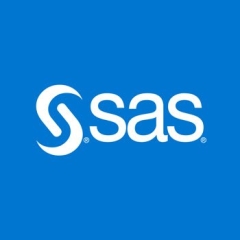What is our primary use case?
We primarily use the product for data analysis and investigations.
What is most valuable?
I think that the ease of use is the most valuable feature. I know SQL. I even taught SQL. But new people who come to the tool without in-depth knowledge of SQL or people who do not have an analytics background can still use the tool. It is very easy for these new users to climb the learning curve using SAS Enterprise Guide because of the way it was created with ease-of-use in mind. It is well-oriented to the business user.
In no time new users are able to create workflows. Obviously, it is best if they have some basic knowledge of how things work in doing analysis — like the concept of joins, data profiling, and maybe some other SQL-related concepts. But the key here is they do not need to know how it is coded or the exact commands. All the features are available within Enterprise Guide through a drag-and-drop interface so queries can be built without extensive knowledge of how that works behind the scenes.
The ease-of-use makes the tool valuable even for someone who is near the beginner level.
What needs improvement?
I think machine learning should be added to the product. It already has virtually everything from the data wrangling perspective. Machine learning concepts could further enhance the user experience and the results.
The concept of visualization could also be added because, currently, we need to use a separate tool. We use Business Objects for data visualizations.
Competing products — like in case of Alteryx that is just in trial versions for now — has both machine learning concepts as well as some of the visualization capabilities within the data profiling features. SAS Guide will have to have these features to keep up with competing products and their capabilities.
If these elements do pan out properly in Alteryx, I may like it better than SAS Enterprise Guide overall. I have a data science background but the more advanced data science features are new in these products and they are very useful in analytics.
So SAS should work on ML (Machine Learning) features, visualizations, and even more on ease-of-use. It is good but everything can get better.
For how long have I used the solution?
I have been working with SAS Enterprise Guide for six years.
What do I think about the stability of the solution?
We have not yet had any stability issues with the product. First of all, it is working well. Secondly, on the hardware side, we thought that we need to have more resources, so we did a capacity planning exercise involving SAS. They gave us some recommendations to improve our environment moving forward. We are installing a new setup on new hardware based on those recommendations. This should maintain our current level of stability and maybe enhance performance.
I feel that SAS has a good foundation. It has not given us a lot of problems when it comes to performance. We were being proactive. It works really well in combination with Teradata, but there is a lot of room for performance optimization with both tools.
Using both platforms — and by that I mean featuring both SAS and Teradata — we do get our data out. In telco, the data volumes are huge, but even though that is the case we do not usually get stuck or experience stability issues.
There are a lot of ways to get the performance optimization you need from products, get the work done, and delegate your time. It takes evaluation and revisions to accomplish those goals.
What do I think about the scalability of the solution?
There are many more business users in our organization, but there are only about seven people who really use Enterprise Guide as technical people. We do not see much of a problem with scalability for either group of users.
How are customer service and technical support?
Technical support is good. Whenever we have a problem, we have technical support sessions. It can be improved, I believe, but I would say that it is not bad either. It works for us.
Which solution did I use previously and why did I switch?
We do use other tools on occasion although we are presently focused on Enterprise Guide as our core in analytics. Ultimately the goal is to get the best results in the easiest way. If that requires changing tools, that may be necessary. Right now we are using SAS along with Teradata.
How was the initial setup?
The initial setup is a bit complex. For the guest access setup, that is something that we do ourselves. But when it comes to the server installation, that is where we require support from SAS. When it comes to the server installation, the configuration is usually done by SAS themselves. The setup is something that is certainly too complex for business users or people who do not have a technical background. It is usually good to involve SAS even if you are going to an upgrade. It can just make things go more smoothly and keep from wasting time with unnecessary issues.
We just have one guy for the maintenance of the system. If there is a problem, then he can rely on support. There is only one guy because the product is pretty stable.
What other advice do I have?
When looking at different tools on the market for data analysis what you need depends on what you want to do. If you have a portfolio within your organization, you may feel that you will need a lot of other tools in addition to make a proper analysis. SAS is a broader solution. It is not just the Enterprise Guide. It has marketing automation and there is even stream processing. Then there is Enterprise Miner. Enterprise Guide is a suite and not just a one-dimensional tool.
If you feel that you are ready to make an investment and you need the capability of advanced analytics within your organization, you will be able to utilize the whole tech stack with Enterprise Guide. If that is the case, then obviously I think you should go for SAS because it is a more mature and evolved product than most other products. In addition, the opportunities for integration with the SAS platform is really good.
If you need a specialty architecture, you have Alteryx on one side and you have SAS on the other side. If you do go with Alteryx, then you have a separate campaign management tool and you may not be able to get the full benefit of an integrated solution.
People considering SAS Enterprise Guide should also look at Alteryx. It is pretty simple. Some people on my team feel that Alteryx is actually much easier to use for what they do and that its interface is much better even if it is similar to Enterprise Guide. The overall availability of different kinds of features is much better in Alteryx.
I think the first step of evaluating potential solutions should be to look at your roadmap. If you want to go start simple, then obviously you can start with any tool. But if you have a roadmap in place or if you are not a beginner, then I would suggest going for one integrated platform as a suite rather than multiple tools. Having an integrated solution is probably a better overall.
On a scale from one to ten where one is the worst and ten is the best, I would rate Enterprise Guide as a seven overall. It is a good product but it lacks some important features other products are coming out with.
Which deployment model are you using for this solution?
On-premises
Disclosure: I am a real user, and this review is based on my own experience and opinions.







